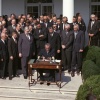In the U.S. edition of The Spectator, Rev. Ben Johnson looks at how President Donald J. Trump eased tariffs on North American and European trade partners so he could ratchet up pressure on China. Yet the Acton Senior Editor offers this caution: “In a trade war, most casualties are self-inflicted.”
More:
Trump is poised to impose a 25 percent tariff on virtually all $535 billion of Chinese imports. Varas estimates that the tariffs on Chinese steel will cost US consumers $58.7 billion. Morgan Stanley forecasts, if this happens we’ll ‘see the global economy heading towards recession.’ And the OECD has warned that a prolonged US-China trade war will reduce global GDP by $600 billion (or 0.7 percent) by 2021-2022.
That’s enough for Trump – a self-described, true believing ‘tariff man’ – to sound a strategic retreat. The president has unilateral authority to regulate any trade he deems a national security threat under Section 232 of the Trade Expansion Act of 1962. The Trump White House still calls foreign vehicles a ‘national security threat, which is causing harm to the American automobile industry.’ A Commerce Department report completed, but not released, on Friday considers lack of US investment in research and development a national security threat.
But critics countered that relatively minor imports from historic allies did not threaten America’s geostrategic position. ‘Tariffs on steel and aluminum were never justified in the first place,’ said Alison Acosta Winters, a senior fellow Americans for Prosperity. French finance minister Bruno Le Maire responded in pique that ‘global trade is not a gunfight at the O.K. Corral.’
Read "Donald Trump’s one-front trade war" in the UK-based magazine.














